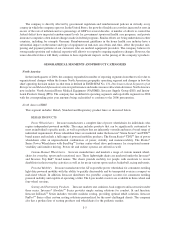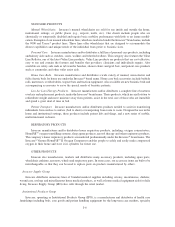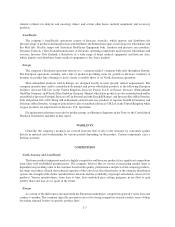Invacare 2006 Annual Report Download - page 17
Download and view the complete annual report
Please find page 17 of the 2006 Invacare annual report below. You can navigate through the pages in the report by either clicking on the pages listed below, or by using the keyword search tool below to find specific information within the annual report.In the U.S., the growth of health care costs has increased at rates in excess of the rate of inflation and as a
percentage of GDP for several decades. A number of efforts to control the federal deficit have impacted
reimbursement levels for government sponsored health care programs and private insurance companies often
imitate changes made in federal programs. Reimbursement guidelines in the home health care industry have a
substantial impact on the nature and type of equipment an end user can obtain and, thus, affect the product mix,
pricing and payment patterns of the company’s customers who are the HME providers.
The company continues its pro-active efforts to shape public policy that impacts home and community-based,
non-acute health care. We are currently very active with federal legislation and regulatory policy makers. Invacare
believes that these efforts give the company a competitive advantage in two ways. First, customers frequently
express appreciation for our efforts on behalf of the entire industry. Second, sometimes we have the ability to
anticipate and plan for changes in public policy, unlike most other HME manufacturers who must react to change
after it occurs.
The Safe Medical Devices Act of 1990 and Medical Device Amendments of 1976 to the Federal Food, Drug
and Cosmetics Act of 1938 (the “Acts”) provide for regulation by the United States Food and Drug Administration
(the “FDA”) of the manufacture and sale of medical devices. Under the Acts, medical devices are classified as
Class I, Class II or Class III devices. The company’s principal products are designated as Class I or Class II devices.
In general, Class I devices must comply with labeling and record keeping requirements and are subject to other
general controls. In addition to general controls, certain Class II devices must comply with product design and
manufacturing controls established by the FDA. Domestic and foreign manufacturers of medical devices distributed
commercially in the U.S. are subject to periodic inspections by the FDA. Furthermore, state, local and foreign
governments have adopted regulations relating to the design, manufacture and marketing of health care products.
During the past year, the company was inspected by the FDA or Health Canada at several domestic and foreign
locations, with no adverse inspectional findings noted. In addition, the management systems of all locations
required to meet ISO 13485 requirements for Canada, Europe and other foreign markets were inspected during 2006
and found to be certifiable.
From time to time, the company may undertake voluntary recalls of our products to maintain ongoing customer
relationships and to enhance its reputation for adhering to high standards of quality and safety. The company
continues to strengthen our programs to better ensure compliance with applicable regulations, particularly those
which could have a material adverse effect on the company.
Although there are a number of reimbursement related issues in most of the countries in which Invacare
competes, the issues of primary importance are currently in the United States. There are two critical issues for
Invacare: eligibility for reimbursement for power wheelchairs for elderly patients and the provisions of the
legislation related to prescription drug coverage under Medicare. With regard to power wheelchairs, the Centers for
Medicare and Medicaid Services, or “CMS,” has recently implemented a series of changes to the eligibility,
documentation, codes and payment rules that impact the predictability and access to this benefit, but the transition
will not be complete until early in 2007. Invacare and the home care industry are working hard to convince the CMS
and the Bush administration to make pragmatic changes, that are consistent with industry practices, to afford seniors
appropriate access to their home medical equipment. See “Management’s Discussion and Analysis of Financial
Condition and Results of Operation.”
Starting in late 2007, competitive bidding for home medical items and services will be implemented in ten of
the largest metropolitan regions of the United States. In 2009, the competitive bidding program will be extended to
80 of the largest metropolitan regions. In early 2006, Congress passed the Deficit Reduction Act which includes
payment cuts to home oxygen that will take effect in January 2009, as well as reductions for certain durable home
medical equipment spending that will take effect in 2007.
Although none of these changes are beneficial to the home care industry, the company believes that we can still
grow and thrive in this environment. The home care industry has not received any cost-of-living adjustments over
the last few years and will try to respond with improved productivity to address the lack of support from Congress.
In addition, the company’s new products (for example, the HomeFill
TM
low-cost oxygen delivery system), can help
address the cuts the home care provider has to endure. The company will continue to focus on developing products
that help the provider improve profitability.
I-13
























